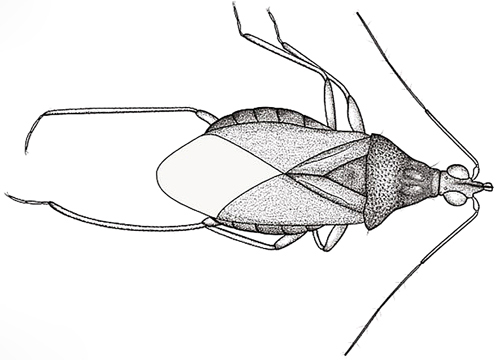Abstract
A remarkable new genus and species, Mecocollaris simplipodus gen. et sp. nov. is described from mid-Cretaceous amber. It is the second fossil record of Nabinae from Myanmar amber. The new species is distinguished from other nabids based on labial segment Ⅲ longer than the combination of segments I, Ⅱ and Ⅳ, hind tibia without clear row of setae corresponding to stiff setae associated with the Ekblom’s organ. By comparing extant species and fossil records of Nabidae, the evolution of the Ekblom’s organ of nabids is discussed.
References
- Becker-Migdisova, E.E. (1962) Otryad Heteroptera. Raznokrylye, ili klopy. In: Rohdendorf, B.B. (Ed.), Osnovy paleontologii, Tom. 9: Chlenistonogie, trakheinye i khelitserovye. Akademiya Nauk SSSR, Moskva, pp. 208–226. [English translation: Becker-Migdisova, E.E., Order Heteroptera. True Bugs. In: Rohdendorf, B.B. (Ed.), Fundamentals of paleontology, Volume 9: Arthropoda, Tracheata, Chelicerata. Trans. Davis, D.R. 1991. Amerind Publishing Co., New Delhi, pp. 289–317.]
- Carayon, J. (1970) Étude des Alloeorhynchus d’Afrique Centrale, avec quelques remarques sur la classification des Nabidae [Hemiptera]. Annales de la Société entomologique de France (N.S.), 6, 899–931. https://doi.org/10.1080/21686351.1970.12277952
- Cockerell, T.D.A. (1927) Fossil insects in the British Museum. Annals and Magazine of Natural History, 20, 585–594. https://doi.org/10.1080/00222932708655492
- Du, S.L., Gu, L., Engel, M.S., Ren, D. & Yao, Y.Z. (2022) Morphological phylogeny of new Cretaceous fossils elucidates the early history of soil dwelling among bugs. Frontiers in Ecology and Evolution, 10, 908044. https://doi.org/10.3389/fevo.2022.908044
- Ekblom, T. (1926) Morphological and biological studies of the Swedish families of Hemiptera-Heteroptera, Part I. The families Saldidae, Nabidae, Lygaeidae, Hydrometridae, Veliidae, and Gerridae. Zoologiska Bidrag, 10, 31–180.
- Garrouste, R., Schubnel, T., Huang, D.Y., Azar, D., Cai, C.Y. & Nel, A. (2020) Sexual conflict during Mesozoic: the first Cretaceous damsel bug in Burmese amber (Hemiptera: Heteroptera: Nabidae). Cretaceous Research, 108 (104344), 1–6. https://doi.org/10.1016/j.cretres.2019.104344
- Germar, E.F. & Berendt, G.C. (1856) Die im Bernstein befindlichen Hemipteren und Orthopteren der vorwelt. In: Berendt, G.C. (Ed.), Die in Bernstein befindlichen Organischen Reste der Vorwelt. Zweiter Band. II Abtheilung. Nicolaischen Buchhandlung, Berlin, 40 pp.
- Grimaldi, D.A. & Ross, A.J. (2017) Extraordinary Lagerstätten in amber, with particular reference to the Cretaceous of Burma. In: Fraser, N.C. & Sues, H.D. (Eds), Terrestrial conservation Lagerstätten: Windows into the evolution of life on land. Dunedin Academic Press, Edinburgh, pp. 287–342. https://doi.org/10.2307/jj.12638994.12
- Heer, O. (1853) Die Insektenfauna der Tertiärgebilde von Oeningen und von Radoboj in Croatien. Dritte Abtheilung: Rhynchoten. W. Engelmann, Leipzig, 138 pp. https://doi.org/10.5962/bhl.title.2469
- Henry, T.J. (2017) Biodiversity of Heteroptera. In: Foottit, R.G. & Adler, P.H. (Eds), Insect biodiversity: Science and society. Vol. I. Second Edition. Wiley-Blackwell, London, pp. 279–335. https://doi.org/10.1016/j.cretres.2012.03.014
- Jordan, K.H.C. (1952) Nabis succini n. sp.—eine Nabidae aus dem Bernstein Ostpreußens (Hemiptera Heteroptera). Beiträge dur Entomologie, 2 (4–5), 455–457.
- Kerzhner, I.M. (1981) Fauna of the USSR. Bugs (Vol. 13, No. 2). Heteroptera of the family Nabidae. Academy of Sciences, USSR, Zoological Institute, Nauka, Leningrad, 327 pp. [In Russian]
- Kim, J., Roca-Cusachs, M. & Jung, S. (2022) Molecular phylogeny of Nabidae (Hemiptera: Heteroptera: Cimicomorpha): Insight into relationships and reclassification with the proposal of the new tribe Stenonabini. Systematic Entomology, 47 (1), 1–12. https://doi.org/10.1111/syen.12512
- Kim, J., Roca-Cusachs, M., Pham, T.H. & Jung, S. (2023) Cretanabis kerzhneri gen. et sp. nov., the oldest nabine genus and species (Hemiptera: Heteroptera: Nabidae) from the mid-Cretaceous Burmese amber. Palaeoentomology, 6 (1), 41–48. https://doi.org/10.11646/palaeoentomology.6.1.7
- Ross, A.J. (2024) Complete checklist of Burmese (Myanmar) amber taxa 2023. Mesozoic, 1 (1), 21–57. https://doi.org/10.11646/mesozoic.1.1.4
- Ma, Y.N., Du, S.L., Ren, D. & Yao, Y.Z. (2024) A new genus and species of the Nabidae (Hemiptera, Heteroptera, Cimicomorpha) from mid-Cretaceous amber of Northern Myanmar. Cretaceous Research, 156, 105796. https://doi.org/10.1016/j.cretres.2023.105796
- Menge, F.A. (1856) Lebenszeichen vorweltlicher, im Bernstein eingeschlossener Thiere. Programm der öffentlichen Prüfung der Schüler der Petrischule. A.W. Kafemann, Danzig, 32 pp.
- Schuh, R.T. & Slater, J.A. (1995) True bugs of the world (Hemiptera: Heteroptera). Classification and natural history. Cornell University Press, Ithaca, New York, 337 pp.
- Schuh, R.T. & Weirauch, C. (2020) True bugs of the World (Hemiptera: Heteroptera). Classification and natural history (Second Edition). Siri Scientific Press, Manchester, 768 pp.
- Shi, G.H., Grimaldi, D.A., Harlow, G.E., Wang, J., Wang, J., Yang, M., Lei, W.Y., Li, Q.L. & Li, X.H. (2012) Age constraint on Burmese amber based on U-Pb dating of zircons. Cretaceous Research, 37, 155–163. https://doi.org/10.1016/j.cretres.2012.03.014
- Swanson, D. & Heads, S. (2020) Rescuing a lost damsel: a revised identity for the extinct true bug Miocoris fagi (Heteroptera). Palaeoentomology, 3 (6), 597–606. https://doi.org/10.11646/palaeoentomology.3.6.11
- Tang, D., Yao, Y.Z. & Ren, D. (2017) Phylogenetic position of the extinct insect family Vetanthocoridae (Heteroptera) in Cimiciformes. Journal of Systematic Palaeontology, 15, 697–708. https://doi.org/10.1080/14772019.2016.1219779
- Tang, H.Y., Wang, Y.X., Ren, D. & Yao, Y.Z. (2022) The first record of vetanthocorids (Hemiptera: Heteroptera: Vetanthocoridae) from mid-Cretaceous amber of northern Myanmar. Cretaceous Research, 131, 105090. https://doi.org/10.1016/j.cretres.2021.105090
- Wang, J.J., Zhang, W.T., Engel, M.S., Sheng, X.Y., Shih, C.K. & Ren, D. (2022) Early evolution of wing scales prior to the rise of moths and butterflies. Current Biology, 32, 3808–3814. https://doi.org/10.1016/j.cub.2022.06.086
- Yang, H.R., Yin, X.C., Lin, X.D., Wang, C., Shih, C.K., Zhang, W.W., Ren, D. & Gao, T.P. (2019) Cretaceous winged stick insects clarify the early evolution of Phasmatodea. Proceedings of the royal society B, 286, 20191085. https://doi.org/10.1098/rspb.2019.1085
- Zhang, J.F. (1986) Some fossil insects from the Jurassic of northern Hebei, China. In: Paleontological Society of Shandong (Ed.), The paleontology and stratigraphy of Shandong. Ocean Press, Beijing, pp. 74–95.
- Zhang, M., Du, S.L., Ren, D. & Yao, Y.Z. (2023) The first fossil record of Cretaceous Ocelloveliinae (Heteroptera: Gerromorpha: Veliidae) revealed its habitat and palaeoclimate. Cretaceous Research, 148, 105542. https://doi.org/10.1016/j.cretres.2023.105542
- Zhang, Y.J., Rasnitsyn, A.P., Zhang, W.T., Song, F., Shih, C.K., Ren, D., Wang, Y.J., Li, H. & Gao, T.P. (2024) Stem chewing lice on Cretaceous feathers preserved in amber. Current Biology, 34, 1–7. https://doi.org/10.1016/j.cub.2024.01.027
- Zhao, Z.P., Yin, X.C., Shih, C.K., Gao, T.P. & Ren, D. (2020) Termite colonies from mid-Cretaceous Myanmar demonstrate their early eusocial lifestyle in damp rotting wood. National Science Review, 7, 381–390. https://doi.org/10.1093/nsr/nwz141


